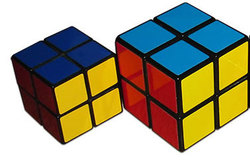Bigger Cubes
 If all the edges of a cube are increased by 30%, what is the percentage (in %) increase of the surface area?
If all the edges of a cube are increased by 30%, what is the percentage (in %) increase of the surface area?
Image credit: Wikipedia Hellbus
The answer is 69.
This section requires Javascript.
You are seeing this because something didn't load right. We suggest you, (a) try
refreshing the page, (b) enabling javascript if it is disabled on your browser and,
finally, (c)
loading the
non-javascript version of this page
. We're sorry about the hassle.
9 solutions
Discussions for this problem are now closed
correct, I also did the same way
I was trying to substitute the s by 10 and the larger cube by 13. And then find the ratio. Great solution anyway!
Solution given by Mr Abdul Kareem is simple and easy to understand K.K.GARG,India
Actually, i always consider math as fun. May be, this is because i always try to give it a practical approach and solve the problems with as least amount of simple calculation as possible. And even in this case.., Assume a square of a round figured length, say 10 A 30% increase would in length would make it 130 on each side To calculate the area; Area before increase in length : 10 10=100 Area after increase in length : 13 13=169 Total in in area : 169-100=69
well, you just KNOW that the total area increases with the square of the linear dimensions, just like you KNOW the volume increases with the cube.
So if a linear dimension increased by 30%, that is like saying you multiplied the old edge length by 1.3
so therefor you have multiplied the AREA by (1.3)^2 = 1.69
so therefore the area has increased by 69%
This you just KNOW.
Now, work it out more politely
1.) say the edge length is E before we started 2.) therefore the area of one face of the cube is E E (E^2) 6.) and the cube has 6 faces, so the total surface area was 6 E^2
Now we increase E by a factor of 1.3
so the NEW area is 6 * (1.3 * E)^2
And the RATIO of the NEW area to the OLD area is then
increase = (6 * (1.3 E)^2 )/ (6 * E^2)
(1.3E) ^2 is the same as (1.3*E) * (1.3 *E)
we can rearrange that as 1.3 * 1.3 * E * E or 1.69 * E^2
giving us the ratio of
(1.69 * 6 * E^2) / (6 * E^2)
the (6*E^2) is in both the top and bottom and divides out (becomes 1), leaving
1.69
or a net increase of 69%, just like we 'new' when we started.
(1.3)^2-1=0.69. and 0.69*100=69%
I did like you!
Step 1 : Assume length of side to be 100 units. S A = 6 a 2 = 6 0 0 0 0 u n i t s 2
Step 2 : Increasing length by 30% will bring the length of side to 130 units. S A ′ = 1 0 1 4 0 0 u n i t s 2
Step 3 : S A ′ − S A = 4 1 4 0 0 u n i t s 2
Step 4 : We have to figure out percentage increase and to do that we jut have to find out what percent of 60000 is equal to 41400 x = 6 0 0 0 0 4 1 4 0 0 × 1 0 0 A n s w e r = 6 9
- Surface Area (SA) = Length (L) * Breadth (B)
- Number of sides to a Cube = 6
- So, Total Surface Area (TSA) = 6 * L * B
If all edges are extended by 30%, then algebraically, New Total Surface Area (NTSA):
NTSA = 6 * (1.3L) * (1.3B)
Factoring out:
NTSA = 1.69 * TSA
Therefore, 69% increase in surface area of the cube.
I think it simple this way 1. First Cube assume it with 1 cm One Area= * 1 * 1=1cm^2 2.Second Cube with 1.3cm One Area= 1.3*1.3=1.69cm^2 So it bigger 0.69/1 *100%=69%
yes....exactly
Surface Area= 6s² ...(A₁)
A₂ = 6(s + .30s)²
A₂ = 6(s + .30s)²
A₂/A₁ = 6(s + .30s)²/6s²
A₂/A₁ = 6s²(1.30)²/6s²
A₂/A₁ = (1.30)²
A₂/A₁ = 1.69
Therefore the area is increased by 69 %
6(10^2) = 100 6[(10*1.3)^2)=169 ((169/100)100%)-100=69%
Change in Surface Area Δ S = ( 6 x 2 6 ( 1 0 0 1 3 0 x ) 2 − 1 ) × 1 0 0 = 6 9 %
Change in Volume Δ V = ( x 3 ( 1 0 0 1 3 0 x ) 3 − 1 ) × 1 0 0 = 1 1 9 . 7 0 %
if one side is 10X(let) of the smaller cube then surface area will be 600X^2 and after increasing the sides new surface area will be 1040X^2......hence ans will be 69%.
This is much simpler way to work out,Thanks K.K.GARG<india
If the side is s, then new side with 30% increase, s ′ = 1 . 3 s Surface area of cube is 6 s 2 New surface area= 6 s ′ 2 = 6 ( 1 . 3 s ) 2 = 6 × 1 . 6 9 s 2 New/old ratio= 1.69, increase = 0 . 6 9 = 6 9 %